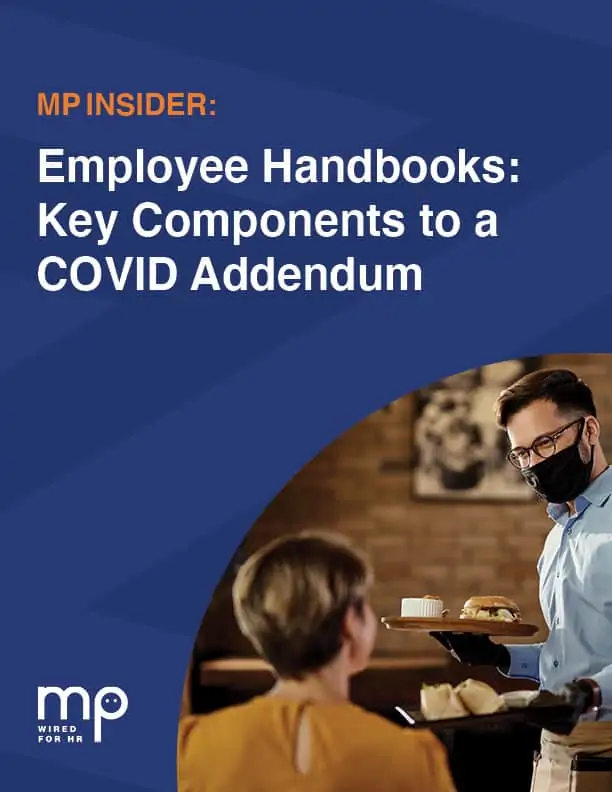Posted on November 18th, 2020
Employee Handbooks: Key Components to a COVID Addendum

MP INSIDER:
Employee Handbooks: Key Components to a COVID Addendum

Table of Contents
- Employee Resources
- Commuting
- Telecommuting and Scheduling During the Pandemic
- Flexible Work Schedule
- Safety and Hygiene Protocols
- Travel
- Personal Travel
- Business Travel
- Leave Policies
- Employee Acknowledgement
Introduction
As COVID cases surge and the pandemic wears on, the best protection a workplace can provide for itself and its workers is an up-to-date, and detailed employee handbook. To keep up with the latest HR updates pertaining specifically to the pandemic, employers should create a COVID addendum for their employee handbook. This section can be especially helpful if it’s prefaced with language that makes it only applicable for the pandemic. Post-pandemic, any temporary leave policy for employees, telecommuting policy, special safety policies, etc. can be voided. Include phrases like “until further notice” or “until the pandemic state of emergency is declared over.” Here is an overview of the main employee policies that should be created and added to a COVID addendum for an employee manual.

Employee Resources
A good place to start is by indicating where an employee can go for more information or questions about COVID procedures. This will help establish trust and camaraderie between management and workers in the common goal of facing the pandemic. Here is an example:
[COMPANY NAME]’s top priority is the health and safety of its employees. If you have questions or concerns about any of the policies in this COVID addendum, or how [COMPANY NAME] is handling any other topics related to the pandemic, please reach out to the HR department. If HR is not immediately available, please share urgent questions or concerns with your manager.
Commuting
Particularly if workers are coming into the workplace on a regular basis, it can be helpful to encourage employees to use the safest commuting methods possible. Encourage staff to avoid public transportation when possible, or to avoid using public transportation during heavy rush hours. If employees must use public transportation, require them to use masks and wash their hands immediately up entering the office. If employees live relatively close to the office, an employer might consider offering a shuttle or carpool service to help them avoid public transportation for the duration of the pandemic.
Telecommuting and Scheduling During the Pandemic

Particularly if an employer hasn’t allowed much remote work before, this section will help workers continue to perform well together. An employee handbook should lay out expectations for how work will get done, evaluated, and shared in a remote environment. When things like this are left undefined, workers and supervisors may make assumptions, responsibilities may go unmet, and serious miscommunications could occur. Best HR practices dictate that a telecommuting policy will detail:
- What tools should be used for work.
- How work can be delivered.
- How important documents will be saved and stored, including naming conventions, folder systems, and shared drives.
- What tools coworkers and managers will use for collaboration, communication, and meetings.
- Expectations for availability and how responsive workers will need to be.
Flexible Work Schedule
Alongside a telework policy, a flexible work schedule policy should also be created. This policy should identify who is eligible for a flexible schedule and who is not. (Creating this policy can help avoid concerns about discrimination.) If employees are working remotely, it will be important to set expectations of core hours or when they are available. The policy should also determine how employees will request overtime and time off. This part is imperative if a business has nonexempt workers. Employers are responsible for paying non-exempt workers for all time worked, so this policy will prevent the employer from racking up expensive payrolls they weren’t expecting.
“The COVID-19 pandemic and the resulting intersection of regulations at both the state and federal level have left employers with some unique dilemmas. All of a sudden, one week of vacation can sometimes turn into an employee being out with pay for close to a month! It is imperative that employers take the time to examine their policies and amend as needed to avoid unnecessary disruptions to their operations.“
Paul Carelis, PHR, SHRM-CP VP of HR & Client Services
Safety and Hygiene Protocols
These employee policies should be specified for COVID safety, as well as the workplace. To start, they should include a provision about sick time and encouraging workers to stay home and/or work from home when they are sick.
A COVID addendum for an employee handbook should detail procedures that must be followed if a worker finds out they were in close contact with somebody who has COVID or is likely to have it. There should also be a section of the policy that outlines the procedure if an employee tests positive for COVID. It should discuss how other employees and managers who were in close proximity will be notified, whether and how the workplace will be shut down, and what sanitization procedures will be used before it reopens.
A section of the policy should be dedicated to practices such as frequent hand washing, cleaning, and sanitizing, as well as mask wearing. It can be helpful to define how a mask must be worn and used. Here are some pertinent bullets to include:
- Ensure your mask completely covers your nose and mouth.
- Hands must be washed before and after removing masks.
- Avoid touching your face when you adjust it during the day.
- Masks should be washed daily, or more often if contamination occurs.
- Masks should never be shared.
- Masks must be kept away from machinery that can get caught in.
- Disposable masks should not be reused and must be thrown away.
- Do not leave masks on any surfaces where they may become contaminated.
- Masks should not be used if they are damaged or have holes.

Strict social distancing guideline should also be outlined, including:
- Avoid in-person meetings. Even when participants are in the same building, use the telephone, online conferencing, email, or instant messaging channels as much as possible.
- If an in-person meeting must occur, minimize meeting time. Choose a large conference room and sit at least 6 (ideally more) feet from each other if possible. Do not engage in physical contact, such as shaking hands or hugs.
- Avoid any unnecessary travel. Cancel or postpone nonessential meetings, gatherings, workshops, and training sessions.
- Do not congregate in work rooms, pantries, copier rooms or other areas on work premises.
- Try to bring lunch or get takeout or delivery. Eat lunch at your desk or outside and away from others.
- When working with vendors or clients, conduct interactions via phone, website, or e-mail to minimize in-person contact. Have orders and materials delivered or dropped off curbside. If the nature of the business requires extra safety procedures during the pandemic, this is a good place to lay them out. For instance, if workers need to interact with customers, what precautions will they take for their own safety and that of the customer?
Lastly, this safety and hygiene section can define requirements for safety outside of the workplace if employees are not remote. Their actions outside the workplace will affect their customers, coworkers, and managers if they’re not careful and are exposed to COVID. Generally, this kind of policy should cover the guidelines suggested by the CDC, as well as state and local health departments, with updates as necessary.

Travel
Employers can create policies for both business and personal travel in their COVID addendum to their employee handbook.
Since remote work has become part of our ‘new normal’ during the pandemic, it’s important to clearly communicate expectations for work performance and security. Many employers are realizing that their employees can effectively work remotely and may choose to allow telework beyond COVID.
Sheri Heller, SHRM-CP, PHR, MEd
Personal Travel
The personal travel section will be especially helpful if employees are coming into the workplace on a regular basis. As mentioned in previous sections, if staff are coming into the workplace, this means their actions will have an impact on customers, coworkers, and managers. Many workplaces are requiring their staff to report all travel done out-of-state. A COVID personal travel policy could state something similar to this:
- Employees who become ill during or within 14 days of returning from travel and have virus-like symptoms must contact a health care provider and their HR department for direction, particularly if they are coming into the workplace.
- Employees returning from travel to high-risk areas who do not exhibit virus-like symptoms must still contact the HR department upon return. They may be directed to get a negative COVID test before returning to the workplace or to remain away from it for 14 days. The returning employee should work with his or her manager to set appropriate telecommuting arrangements or request time off from work.
This travel policy should also discuss whether quarantine time will be paid or unpaid. Additionally, it should state whether employees will be required to use accrued time off, or if they are eligible for any state or federal leaves. Note that state and federal COVID laws and regulations will come into play and an employer should consult with their HR department and HR consulting provider about this topic.
Having a COVID addendum gives managers and supervisors policies and procedures to refer to during these unprecedented times.
Amanda Bridge, SHRM-CP

Business Travel
For business travel, the policy can distinguish necessary and unnecessary trips. Essential business travel can be defined with this language:
Business travel can occur when tasks cannot reasonably be conducted without in-person interaction or visits to specific locations. Managers must approve all travel (including trips that were previously approved) until further notice.
A business travel section should also lay out expectations for how an employee will behave, including following all relevant CDC, as well as state and local guidelines. They might be required to use cars rather than public transportation or flying. If so, the employer should provide a voucher for the car or rent a car. It’s also possible that a business travel policy for the pandemic can flatly prohibit any business travel for the duration of the pandemic.
Leave Policies
This section should outline all the available policies that workers can choose from should they need them. It can include the usual PTO policies and sick time. These may be amended for the current circumstances. For instance, workers may be temporarily allowed to use up sick and PTO time before it’s accrued if they’re dealing with their own illness, a family illness, or a lack of childcare. This section should also list out the various leave options (including relevant state and federal ones) and how they will apply. The policy should indicate who an employee will need to notify if they must take leave and what they will need to apply for it. It should also clarify what the next steps should include (for instance, keeping in touch with a manager about plans for returning to work).

Employee Acknowledgement
An acknowledgement will make a COVID addendum far more effective. It can be done electronically or on paper. Every employee’s acknowledgement with a signature should be collected and saved in an HR management system until the pandemic is over and the addendum is no longer needed. A sample acknowledgement could include language such as:
I have received and read a copy of [ORGANIZATION’S NAME]’s COVID-19 Handbook Addendum and Workplace Safety Policies and I agree to follow them. I understand that, should I fail to fully comply with any of these policies, I may be subject to discipline or termination. I also understand that the pandemic, as well as CDC guidance and federal and state laws surrounding the pandemic, are changing rapidly. Thus, these policies may change to be in compliance with new information, laws, regulations, and guidance.
Trust MP to Help
MP has been a leading provider of HR and payroll solutions for companies across the US for nearly two decades. We offer a comprehensive suite of products and services delivered in one unified, easy-to-use platform. We support clients as they cultivate excellent corporate culture, improve employee engagement, and strive towards their business goals. Since 2014, MP has been on the Inc 5000 list and has won the Boston Business Journal Fastest Growing Companies Award.

